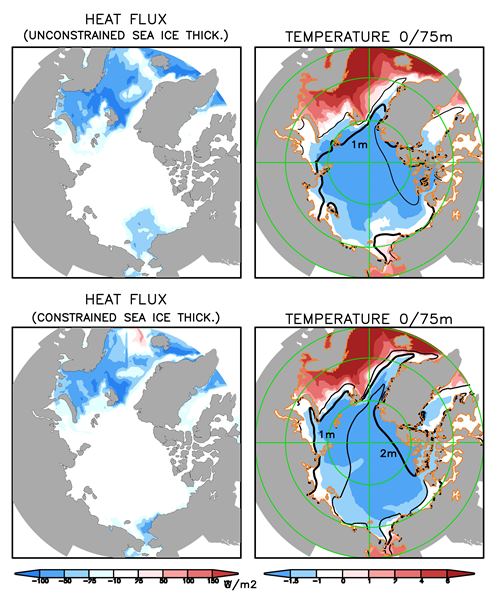Abstract's details
Sea ice thickness estimates impact temperature and heat flux estimates in the Arctic Ocean
Event: 2019 Ocean Surface Topography Science Team Meeting
Session: Science IV: Altimetry for Cryosphere and Hydrology
Presentation type: Poster
Many environmental variables of interest are poorly constrained in the Arctic, including ice thickness, ocean temperature, and net surface heat flux. In addition to improving sea ice thickness estimates the recent development of altimeter freeboard techniques also offers the potential to improve ocean temperature and net surface heat flux. We begin discussing the energy budget of the Arctic Ocean/sea ice system, pointing out that the high thermal diffusivity of sea ice affects the amount of heat the Arctic Ocean receives (independent of its impact on albedo). Improving estimates of sea ice thickness within an ocean/sea ice reanalysis system alters the geographic and seasonal input and loss of heat from the ocean causing potentially large changes in upper ocean temperature estimates.
In the second part of the presentation we present a series of experiments carried out with a coupled ocean/sea ice model and a sequential data assimilation system, an example of which is shown in Fig. 1. The upper two panels present the ten year (1991-1999) mean (left) net surface heat flux and (right) 0/75m average temperature for a reanalysis forced by ERA-Interim surface variables (winds, downwelling radiation, Ta, qa, SLP, and precipitation). The righthand panel also has time mean ice thickness in black contours superimposed (solid contours show isolines of 1m and 2m thickness). All historical temperature and salinity observations are assimilated. The lower two panels present the ten year (1991-1999) mean (left) net surface heat flux and (right) 0/75m average temperature for a reanalysis experiment that only differs in that sea ice thickness is constrained (using an enthalpy-based assimilation algorithm) to match, in this example, the thicker PIOMAS analysis of Zhang et al. (2004). The increased thickness of the sea ice is evident by comparing the distribution of contours in the righthand panels.
Even though the only aspect of the reanalysis data that has changed is sea ice thickness, both net surface heat flux and upper ocean temperature are considerably altered. The changes to net surface heat flux are most evident in locations where the sea ice has gotten thicker such as the Chukchi Sea north of Bering Strait (compare lefthand panels). There the increase in ice thickness reduces net surface heat loss by more than 30Wm-2 with much of this heat loss occurring in fall and early winter. On the Atlantic side of the Arctic increases in sea ice thickness reduce wintertime heat loss in the Nordic Seas. In some regions such as the Chukchi Sea these increases in sea ice cover lead, counter-intuitively, to lower ocean temperatures because of their effects on reduction in absorption of sunlight in summer (compare righthand panels).

Back to the list of abstractIn the second part of the presentation we present a series of experiments carried out with a coupled ocean/sea ice model and a sequential data assimilation system, an example of which is shown in Fig. 1. The upper two panels present the ten year (1991-1999) mean (left) net surface heat flux and (right) 0/75m average temperature for a reanalysis forced by ERA-Interim surface variables (winds, downwelling radiation, Ta, qa, SLP, and precipitation). The righthand panel also has time mean ice thickness in black contours superimposed (solid contours show isolines of 1m and 2m thickness). All historical temperature and salinity observations are assimilated. The lower two panels present the ten year (1991-1999) mean (left) net surface heat flux and (right) 0/75m average temperature for a reanalysis experiment that only differs in that sea ice thickness is constrained (using an enthalpy-based assimilation algorithm) to match, in this example, the thicker PIOMAS analysis of Zhang et al. (2004). The increased thickness of the sea ice is evident by comparing the distribution of contours in the righthand panels.
Even though the only aspect of the reanalysis data that has changed is sea ice thickness, both net surface heat flux and upper ocean temperature are considerably altered. The changes to net surface heat flux are most evident in locations where the sea ice has gotten thicker such as the Chukchi Sea north of Bering Strait (compare lefthand panels). There the increase in ice thickness reduces net surface heat loss by more than 30Wm-2 with much of this heat loss occurring in fall and early winter. On the Atlantic side of the Arctic increases in sea ice thickness reduce wintertime heat loss in the Nordic Seas. In some regions such as the Chukchi Sea these increases in sea ice cover lead, counter-intuitively, to lower ocean temperatures because of their effects on reduction in absorption of sunlight in summer (compare righthand panels).
